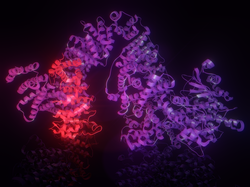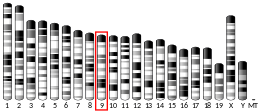Ataxia telangiectasia and Rad3 related
Serine/threonine-protein kinase ATR also known as ataxia telangiectasia and Rad3-related protein (ATR) or FRAP-related protein 1 (FRP1) is an enzyme that, in humans, is encoded by the ATR gene.[5][6] ATR belongs to the phosphatidylinositol 3-kinase-related kinase protein family. ATR is activated in response to single strand breaks.
Function
ATR is a serine/threonine-specific protein kinase that is involved in sensing DNA damage and activating the DNA damage checkpoint, leading to cell cycle arrest.[7] ATR is activated in response to persistent single-stranded DNA, which is a common intermediate formed during DNA damage detection and repair. Single-stranded DNA occurs at stalled replication forks and as an intermediate in DNA repair pathways such as nucleotide excision repair and homologous recombination repair. ATR works with a partner protein called ATRIP to recognize single-stranded DNA coated with RPA.[8] Once ATR is activated, it phosphorylates Chk1, initiating a signal transduction cascade that culminates in cell cycle arrest. In addition to its role in activating the DNA damage checkpoint, ATR is thought to function in unperturbed DNA replication.[9]
ATR is related to a second checkpoint-activating kinase, ATM, which is activated by double strand breaks in DNA or chromatin disruption.[10]
Clinical significance
Mutations in ATR are responsible for Seckel syndrome, a rare human disorder that shares some characteristics with ataxia telangiectasia, which results from ATM mutation.[11]
ATR is also linked to familial cutaneous telangiectasia and cancer syndrome.[12]
Inhibitors
ATR/ChK1 inhibitors can potentiate the effect of DNA cross-linking agents such as cisplatin[13] and nucleoside analogues such as gemcitabine.[14] The first clinical trials using inhibitors of ATR have been initiated by AstraZeneca, preferably in ATM-mutated chronic lymphocytic leukaemia (CLL), prolymphocytic leukaemia (PLL) or B-cell lymphoma patients and by Vertex Pharmaceuticals in advanced solid tumours.[15]
Examples include
Aging
Deficiency of ATR expression in adult mice leads to the appearance of age-related alterations such as hair graying, hair loss, kyphosis (rounded upper back), osteoporosis and thymic involution.[16] Furthermore, there are dramatic reductions with age in tissue-specific stem and progenitor cells, and exhaustion of tissue renewal and homeostatic capacity.[16] There was also an early and permanent loss of spermatogenesis. However, there was no significant increase in tumor risk.
Seckel syndrome
In humans, hypomorphic mutations (partial loss of gene function) in the ATR gene are linked to Seckel syndrome, an autosomal recessive condition characterized by proportionate dwarfism, developmental delay, marked microcephaly, dental malocclusion and thoracic kyphosis.[17] A senile or progeroid appearance has also been frequently noted in Seckel patients.[16]
Homologous recombinational repair
Somatic cells of mice deficient in ATR have a decreased frequency of homologous recombination and an increased level of chromosomal damage.[18] This finding implies that ATR is required for homologous recombinational repair of endogenous DNA damage.
Drosophila mitosis and meiosis
Mei-41 is the Drosophila ortholog of ATR.[19] During mitosis in Drosophila DNA damages caused by exogenous agents are repaired by a homologous recombination process that depends on mei-41(ATR). Mutants defective in mei-41(ATR) have increased sensitivity to killing by exposure to the DNA damaging agents UV ,[20] and methyl methanesulfonate.[20][21] Deficiency of mei-41(ATR) also causes reduced spontaneous allelic recombination (crossing over) during meiosis[20] suggesting that wild-type mei-41(ATR) is employed in recombinational repair of spontaneous DNA damages during meiosis.
Interactions
Ataxia telangiectasia and Rad3 related has been shown to interact with:
References
- GRCh38: Ensembl release 89: ENSG00000175054 - Ensembl, May 2017
- GRCm38: Ensembl release 89: ENSMUSG00000032409 - Ensembl, May 2017
- "Human PubMed Reference:". National Center for Biotechnology Information, U.S. National Library of Medicine.
- "Mouse PubMed Reference:". National Center for Biotechnology Information, U.S. National Library of Medicine.
- Cimprich KA, Shin TB, Keith CT, Schreiber SL (Apr 1996). "cDNA cloning and gene mapping of a candidate human cell cycle checkpoint protein". Proceedings of the National Academy of Sciences of the United States of America. 93 (7): 2850–5. doi:10.1073/pnas.93.7.2850. PMC 39722. PMID 8610130.
- Bentley NJ, Holtzman DA, Flaggs G, Keegan KS, DeMaggio A, Ford JC, Hoekstra M, Carr AM (Dec 1996). "The Schizosaccharomyces pombe rad3 checkpoint gene". The EMBO Journal. 15 (23): 6641–51. doi:10.1002/j.1460-2075.1996.tb01054.x. PMC 452488. PMID 8978690.
- Sancar A, Lindsey-Boltz LA, Unsal-Kaçmaz K, Linn S (2004). "Molecular mechanisms of mammalian DNA repair and the DNA damage checkpoints". Annual Review of Biochemistry. 73 (1): 39–85. doi:10.1146/annurev.biochem.73.011303.073723. PMID 15189136.
- Zou L, Elledge SJ (Jun 2003). "Sensing DNA damage through ATRIP recognition of RPA-ssDNA complexes". Science. 300 (5625): 1542–8. doi:10.1126/science.1083430. PMID 12791985.
- Brown EJ, Baltimore D (Mar 2003). "Essential and dispensable roles of ATR in cell cycle arrest and genome maintenance". Genes & Development. 17 (5): 615–28. doi:10.1101/gad.1067403. PMC 196009. PMID 12629044.
- Bakkenist CJ, Kastan MB (Jan 2003). "DNA damage activates ATM through intermolecular autophosphorylation and dimer dissociation". Nature. 421 (6922): 499–506. doi:10.1038/nature01368. PMID 12556884.
- O'Driscoll M, Ruiz-Perez VL, Woods CG, Jeggo PA, Goodship JA (Apr 2003). "A splicing mutation affecting expression of ataxia-telangiectasia and Rad3-related protein (ATR) results in Seckel syndrome". Nature Genetics. 33 (4): 497–501. doi:10.1038/ng1129. PMID 12640452.
- "OMIM Entry - # 614564 - CUTANEOUS TELANGIECTASIA AND CANCER SYNDROME, FAMILIAL; FCTCS". omim.org.
- Hall, Amy B.; Newsome, Dave; Wang, Yuxin; Boucher, Diane M.; Eustace, Brenda; Gu, Yong; Hare, Brian; Johnson, Mac A.; Li, Howard; Milton, Sean; Murphy, Cheryl E.; Takemoto, Darin; Tolman, Crystal; Wood, Mark; Charlton, Peter; Charrier, Jean-Damien; Furey, Brinley; Golec, Julian; Reaper, Philip M.; Pollard, John R. (30 July 2014). "Potentiation of tumor responses to DNA damaging therapy by the selective ATR inhibitor VX-970". Oncotarget. 5 (14): 5674–5685. doi:10.18632/oncotarget.2158.
- Dunlop, Charles R.; Wallez, Yann; Johnson, Timothy Isaac; Bernaldo de Quirós Fernández, Sandra; Durant, Stephen T.; Cadogan, Elaine B.; Lau, Alan; Richards, Frances M.; Jodrell, Duncan I. (3 August 2020). "Complete loss of ATM function augments replication catastrophe induced by ATR inhibition and gemcitabine in pancreatic cancer models". British Journal of Cancer. doi:10.1038/s41416-020-1016-2.
- Llona-Minguez S, Höglund A, Jacques SA, Koolmeister T, Helleday T (May 2014). "Chemical strategies for development of ATR inhibitors". Expert Reviews in Molecular Medicine. 16 (e10): e10. doi:10.1017/erm.2014.10. PMID 24810715.
- Ruzankina Y, Pinzon-Guzman C, Asare A, Ong T, Pontano L, Cotsarelis G, Zediak VP, Velez M, Bhandoola A, Brown EJ (2007). "Deletion of the developmentally essential gene ATR in adult mice leads to age-related phenotypes and stem cell loss". Cell Stem Cell. 1 (1): 113–26. doi:10.1016/j.stem.2007.03.002. PMC 2920603. PMID 18371340.
- O'Driscoll M, Jeggo PA (2006). "The role of double-strand break repair - insights from human genetics". Nat. Rev. Genet. 7 (1): 45–54. doi:10.1038/nrg1746. PMID 16369571.
- Brown AD, Sager BW, Gorthi A, Tonapi SS, Brown EJ, Bishop AJ (2014). "ATR suppresses endogenous DNA damage and allows completion of homologous recombination repair". PLoS ONE. 9 (3): e91222. doi:10.1371/journal.pone.0091222. PMC 3968013. PMID 24675793.
- Shim HJ, Lee EM, Nguyen LD, Shim J, Song YH (2014). "High-dose irradiation induces cell cycle arrest, apoptosis, and developmental defects during Drosophila oogenesis". PLoS ONE. 9 (2): e89009. doi:10.1371/journal.pone.0089009. PMC 3923870. PMID 24551207.
- Baker BS, Boyd JB, Carpenter AT, Green MM, Nguyen TD, Ripoll P, Smith PD (1976). "Genetic controls of meiotic recombination and somatic DNA metabolism in Drosophila melanogaster". Proc. Natl. Acad. Sci. U.S.A. 73 (11): 4140–4. doi:10.1073/pnas.73.11.4140. PMC 431359. PMID 825857.
- Rasmuson A (1984). "Effects of DNA-repair-deficient mutants on somatic and germ line mutagenesis in the UZ system in Drosophila melanogaster". Mutat. Res. 141 (1): 29–33. doi:10.1016/0165-7992(84)90033-2. PMID 6090892.
- Kim ST, Lim DS, Canman CE, Kastan MB (Dec 1999). "Substrate specificities and identification of putative substrates of ATM kinase family members". The Journal of Biological Chemistry. 274 (53): 37538–43. doi:10.1074/jbc.274.53.37538. PMID 10608806.
- Tibbetts RS, Cortez D, Brumbaugh KM, Scully R, Livingston D, Elledge SJ, Abraham RT (Dec 2000). "Functional interactions between BRCA1 and the checkpoint kinase ATR during genotoxic stress". Genes & Development. 14 (23): 2989–3002. doi:10.1101/gad.851000. PMC 317107. PMID 11114888.
- Chen J (Sep 2000). "Ataxia telangiectasia-related protein is involved in the phosphorylation of BRCA1 following deoxyribonucleic acid damage". Cancer Research. 60 (18): 5037–9. PMID 11016625.
- Gatei M, Zhou BB, Hobson K, Scott S, Young D, Khanna KK (May 2001). "Ataxia telangiectasia mutated (ATM) kinase and ATM and Rad3 related kinase mediate phosphorylation of Brca1 at distinct and overlapping sites. In vivo assessment using phospho-specific antibodies". The Journal of Biological Chemistry. 276 (20): 17276–80. doi:10.1074/jbc.M011681200. PMID 11278964.
- Schmidt DR, Schreiber SL (Nov 1999). "Molecular association between ATR and two components of the nucleosome remodeling and deacetylating complex, HDAC2 and CHD4". Biochemistry. 38 (44): 14711–7. CiteSeerX 10.1.1.559.7745. doi:10.1021/bi991614n. PMID 10545197.
- Wang Y, Qin J (Dec 2003). "MSH2 and ATR form a signaling module and regulate two branches of the damage response to DNA methylation". Proceedings of the National Academy of Sciences of the United States of America. 100 (26): 15387–92. doi:10.1073/pnas.2536810100. PMC 307577. PMID 14657349.
- Fabbro M, Savage K, Hobson K, Deans AJ, Powell SN, McArthur GA, Khanna KK (Jul 2004). "BRCA1-BARD1 complexes are required for p53Ser-15 phosphorylation and a G1/S arrest following ionizing radiation-induced DNA damage". The Journal of Biological Chemistry. 279 (30): 31251–8. doi:10.1074/jbc.M405372200. PMID 15159397.
- Bao S, Tibbetts RS, Brumbaugh KM, Fang Y, Richardson DA, Ali A, Chen SM, Abraham RT, Wang XF (Jun 2001). "ATR/ATM-mediated phosphorylation of human Rad17 is required for genotoxic stress responses". Nature. 411 (6840): 969–74. doi:10.1038/35082110. PMID 11418864.
- Long X, Lin Y, Ortiz-Vega S, Yonezawa K, Avruch J (Apr 2005). "Rheb binds and regulates the mTOR kinase". Current Biology. 15 (8): 702–13. doi:10.1016/j.cub.2005.02.053. PMID 15854902.
Further reading
- Giaccia AJ, Kastan MB (Oct 1998). "The complexity of p53 modulation: emerging patterns from divergent signals". Genes & Development. 12 (19): 2973–83. doi:10.1101/gad.12.19.2973. PMID 9765199.
- Shiloh Y (Feb 2001). "ATM and ATR: networking cellular responses to DNA damage". Current Opinion in Genetics & Development. 11 (1): 71–7. doi:10.1016/S0959-437X(00)00159-3. PMID 11163154.
- Kastan MB, Lim DS (Dec 2000). "The many substrates and functions of ATM". Nature Reviews Molecular Cell Biology. 1 (3): 179–86. doi:10.1038/35043058. PMID 11252893.
- Abraham RT (2005). "The ATM-related kinase, hSMG-1, bridges genome and RNA surveillance pathways". DNA Repair. 3 (8–9): 919–25. doi:10.1016/j.dnarep.2004.04.003. PMID 15279777.
- Li L, Li HS, Pauza CD, Bukrinsky M, Zhao RY (2006). "Roles of HIV-1 auxiliary proteins in viral pathogenesis and host-pathogen interactions". Cell Research. 15 (11–12): 923–34. doi:10.1038/sj.cr.7290370. PMID 16354571.
External links
- Drosophila meiotic-41 - The Interactive Fly
- Human ATR genome location and ATR gene details page in the UCSC Genome Browser.




